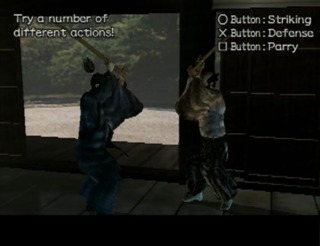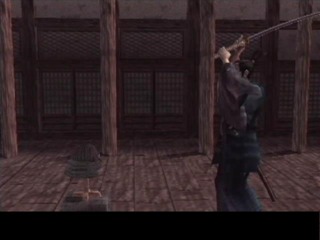Overview
Kengo: Master of Bushido, known in Japan and in-game simply as Kengo (or Kengō, meaning "Swordsman"), is a 3D historical-fantasy weapon-based fighting game developed and published by Genki (in conjunction with LightWeight) for the PlayStation 2 in Japan on December 4, 2000, with a North American release by Crave on January 3, 2001 and a European release by both Crave and Ubisoft on March 30, 2001.
Developed by the studio behind the Bushido Blade series, Kengo is set in Japan's late-17th, early-18th century and focuses on period-accurate kenjutsu and an elaborate single-player campaign where players train their chosen swordsman with various mini-games, customize their technique using attacks learned from the eight fighting schools and work their way to being their dojo's master. It later received three sequels, as well as a Xbox spin-off.
Promotional material for the Japanese version of the game boasts its celebrity tie-in with actor and martial artist Hiroshi Fujioka, who is one of the game's advisors.
Gameplay
 Practice makes perfect!
Practice makes perfect!Kengo plays similar to other 3D fighting games, although focused more on realistic depictions of kenjutsu.
Rather than multiple attack buttons, Kengo has players instead choose from four "stances" using the shoulder buttons (L1, L2, R1, and R2) and pressing the Circle button multiple times to progress through the combo (which can have up to three linked strikes). Each swordsman have different combos, which can be customized in the Single Player mode.
For defense, players can either block by holding the Cross button or perform a riskier short-timed parry by tapping the Square button. Successful parries leave the opponent open to a counterattack and improves the wielder's Ki, but puts them at a risk of getting hit on mistimed parries. Continuously blocking depletes the user's Ki, putting them at risk of being guard crushed. The Square button can also be used to "cross swords", depleting both combatants' Ki.
In most cases throughout the game, each duel is fought with real blades in a classic "battle to the death", with over-the-top blood splatter similar to chanbara films (which is disabled by default in the Options menu). At times, hits with these blades can cause a mortal wound, slowly depleting the opponent's HP through uncontrollable bleeding. Despite the lethality of these battles, the game does not have a death mechanic.
Ki Meter & Secret Techniques
The game includes a unique super meter at the bottom of the HUD, known as the "Ki Meter', which fills by scoring hits, successfully parrying attacks, and performing battle cries. However, it depletes by missing swings, having an attack blocked or parried, and basic defending.
While it is primarily used for gaining forward momentum, as high Ki improves overall swordplay, it is also used when it is at its maximum level for the Secret Technique. Performed by pressing the Triangle button (but can be cancelled with the Cross button) when having an Excellent Sword equipped, the Secret Technique is a special and powerful combo that is unique to each sword (even when bokken is used in Single Player mode).
Game Modes
Single Player
The game's main single-player mode puts players in control of one of three swordsmen (the all-rounder Taketsune, the agile Shozaemon, or the striker Yasutomo) as they train within one of eight dojo of their choosing (each focused on a particular school of swordfighting). Throughout the campaign, players upgrade each of their swordfighting attributes through sparring and personal training, work to become their dojo's disciple, challenge other dojo for fame and knowledge, and participate in the coveted Imperial Tournament. Although the game has no endpoint, the credits roll after winning the Tournament and succeeding their dojo's master after one final showdown.
 Using a famed sword to chop some wigs.
Using a famed sword to chop some wigs.This mode uses two types of swords: standard bladed swords and wooden practice swords (bokken). Bokken is used when sparring with other students or challenging other dojo, and is only different by not inflicting mortal wounds. Throughout the game, players can earn (and, failing in the endgame, lose) the "Excellent Sword" of other dojo, which can be used for the dojo's specific Secret Technique.
One of the key aspects of this mode is the ability to customize the swordsman's four combos (also known as "stances" or "forms") with all of their learned techniques. They start with some techniques from their dojo and can learn more by testing themselves against their fellow students and challenging other dojo. Each combo is a combination of three techniques, several of which link together more efficiently than others. There are over 70 techniques in total.
Stats & Self-Training
 While doing meditation training, it's important not to get... board.
While doing meditation training, it's important not to get... board. Similar to RPGs, each swordsman has five main attributes to their swordfighting: Attack Power, Attack Speed, Agility, Insight, and Spirit. The first two improve sword strikes, the second two improve evasive maneuvers, and the final one improves Ki generation.
While they are improved over time through combat, players can improve them manually through unique training mini-games. The mini-games can also be used to improve the maximum amount of each stat.
- Striking Posts - Can increase the maximum of the Attack Power stat.
- Helmet Splitting - Can increase the maximum of the Attack Speed stat. Only available if an Excellent Sword is equipped, and failing it renders it unusable for a few days.
- Bamboo Grove - Can increase the maximum of the Agility stat.
- Zen Meditation - Can increase the maximum of the Insight stat.
- Waterfall - Can increase the maximum of the Spirit stat.
- Illusion - Can increase the maximum of all five stats.
Tournament & VS Mode
Other than the main Single Player mode, the game includes two alternate modes: the one-player Tournament and the two-player VS Mode. Both allows players to choose from a roster of unique characters the player fights in Single Player, along with the default trio and a saved Single Player swordsman (via two Memory Card slots, allowing players to battle each other's customized swordsman).
- The Tournament mode tasks players with defeating all 30 opponents as fast as they can. The opponent lineup is each of the eight dojos' students, followed by the three player swordsmen, each of the eight dojos' disciples, each of the eight dojos' masters, and each of the four bonus characters.
- The VS Mode is a simple one-on-one mode. Rounds can be enabled in the Options menu.
Characters & Schools
In the main single-player mode, players choose from one of three swordsmen, each with their own stats:
- Taketsune Nakayama - Overall all-rounder.
- Shozaemon Hyuga - Excels in faster movement and dodging.
- Yasutomo Yoshimura - Excels in stronger and faster attacks.
They then choose one of eight dojo, each focused on a particular fighting school, which determines the types of techniques the player learns early in the game. As they challenge other dojo, they learn additional techniques from them and can earn their special sword (which determines the player's secret technique).
- Muja School (Hirata Dojo)
- Suigetsu School (Moriya Dojo)
- Kyoshin School (Kasukabe Dojo)
- Muni School (Ooishi Dojo)
- Muishinjin School (Tanbara Dojo)
- Isshin School (Udagawa Dojo)
- Kumomushin School (Tsubaki Dojo)
- Fudo School (Kadokura Dojo)
Along with generic "student" opponents, each dojo has two special opponents: the dojo's disciple and the dojo's master. They can all be playable in the game's other modes, with the student characters requiring a special button combination.
Disciples
They are unlocked in other modes by default.
- Kangoro Morobushi (Muja)
- Toranosuke Matsui (Suigetsu)
- Enshiro Tanabe (Kyoshin)
- Tatsunao Kirigamine (Muni)
- Hideyasu Takagi (Muishinjin)
- Kotaro Suzuoki (Isshin)
- Seiichiro Shirai (Kumomushin)
- Kanenobu Nimura (Fudo)
Masters
They are unlockable for other modes.
- Juuro Hirata (Muja)
- Genpo Moriya (Suigetsu)
- Ichiun Kasukabe (Kyoshin)
- Gettan Ooishi (Muni)
- Zesuiken Tanbara (Muishinjin)
- Kakuma Udagawa (Isshin)
- Jiroemon Tsubaki (Kumomushin)
- Shigetoshi Kadokura (Fudo)
The game also includes three bonus characters that can be encountered in the single-player mode's Imperial Match and at the final battles of Tournament Mode. They can be unlocked for other modes.
A final hidden character, Ikosai (the founder of Kage-ryū), serves as the final boss of Tournament Mode and requires a special button combination to play.
Log in to comment